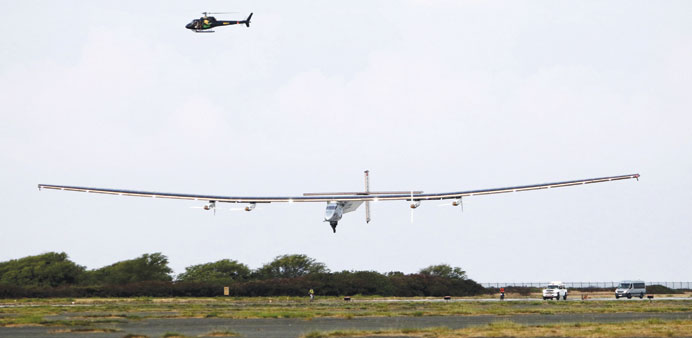The Solar Impulse 2 airplane, piloted by Andre Borschberg, lands at Kalaeloa Airport in Kapolei, Hawaii, after flying non-stop from Nagoya, Japan. The Solar Impulse, which took off from Japan on Monday on the seventh leg of its journey and landed in Hawaii early yesterday, shattered the solo-flight record threshold of 76 hours whilst crossing the Pacific.
A Swiss man attempting to circumnavigate the globe with an aircraft powered only by the sun’s energy landed in Hawaii yesterday, after a record-breaking five-day nonstop solo flight across the Pacific Ocean from Japan.
The Solar Impulse 2 is the first aircraft to fly day and night without any fuel.
Pilot Andre Borschberg’s 120-hour voyage shattered the 76-hour record for nonstop flight by late American adventurer Steve Fossett in 2006 on the Virgin Atlantic Global Flyer.
Borschberg, who took off from Nagoya, Japan, on Monday on the seventh leg of the journey, landed at 5.55am (1555 GMT) yesterday in Kalaeloa Airport after five days and nights.
“Just landed in #Hawaii with @solarimpulse! For @bertrandpiccard and I, it’s a dream coming true,” Borschberg tweeted triumphantly upon after completing the most dangerous leg of the around-the-world journey.
The aircraft, piloted alternatively by Swiss explorers Borschberg and Bertrand Piccard, set off on its 22,000-mile (35,000km) journey around the world from Abu Dhabi on March 9.
Piccard expressed elation over the arrival of aircraft and pilot.
“Difficult to believe what I see: #Si2 in Hawaii! But I never had doubts that @andreborschberg could make it!” he wrote on Twitter. “This flight to Hawaii is not only an aviation historic first, but also a historic first for energy and clean techs.”
The next leg would be from Honolulu to Phoenix, Arizona, and then Borschberg and Piccard will fly together across the Atlantic on a return path to Abu Dhabi.
Borschberg navigates alone in an unheated and unpressurised cockpit, sleeping in bursts of 20 minutes while on autopilot.
Addressing the pilot on a live online broadcast from the Solar Impulse Mission Control Centre in Monaco, an ecstatic Peter Frei, head of the project’s conceptual design and aerodynamics, congratulated the team on 12 years of work culminating in what he called a historic moment.
“Andre, what you did is unbelievable,” Frei said. “I can’t even imagine what it takes to be five days up there, with so little sleep and such a complex and crippled aircraft.”
Studies, design and construction took 12 years and a first version of the plane rolled out in 2009 and broke records for heights and distances travelled by a manned solar plane.
The solar plane was created in order to encourage governments to replace pollutants with (clean tech) clean technology.
“Our airplane has not been built to carry passengers but to convey a message,” says Piccard.
The experimental plane touched down in Hawaii shortly after dawn amid cheers and applause from the ground crew.
Borschberg, all smiles, emerged a short time time later from the cockpit.
Sunlight glimmered on the horizon as the Solar Impulse ground crew burst into cheers and applause upon completion of the groundbreaking flight, whose progress was streamed live at the solar impulse website.
As the flight neared its destination, the Solar Impulse team tweeted images and videos of the plane over Hawaii.
Earlier yesterday, founder of Virgin Group Richard Branson congratulated the Solar Impulse team on Twitter for beating Virgin’s record non-stop solo flight without refueling.
“The #solarteam made it. WE MADE IT, YOU MADE IT THANKS TO YOUR SUPPORT!”read a message posted under the Twitter handle @solarimpulse.
The aircraft over the course of the journey set records for longest solo flight and most time in a solar-powered flight.
The flight tested its exhausted pilot to the limit, in what his team described as “difficult” conditions
Travelling at altitudes of more than 9,000m (29,500 feet), Borschberg at times had to use oxygen tanks to breathe and experienced huge swings in temperature throughout.
Solar Impulse 2 has 17,000 solar cells and on-board rechargeable lithium batteries, allowing it to fly through the night.
Its wingspan is longer than that of a jumbo jet but it weighs only 2.3 tonnes – about the same as a car.

